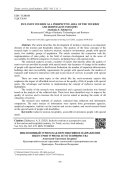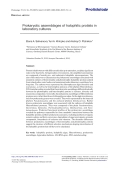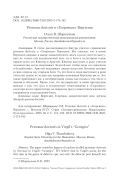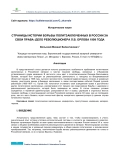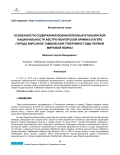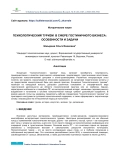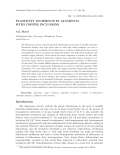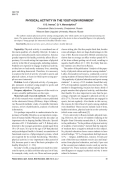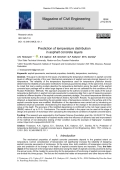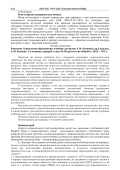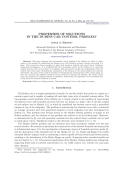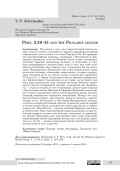анализ понятийного аппарата по теме исследования: инклюзивный туризм, инклюзивная среда, ограничения жизнедеятельности, маломобильные группы населения, инвалидность. Рассматривается связь реализации государственной политики в сфере развития туризма и основных направлений обеспечения доступности разным категориям граждан, в том числе с особыми потребностями.
Посредством статистического анализа выявлен ряд факторов, непосредственно влияющих на качество оказания туристических услуг людям с особыми потребностями: динамика численности инвалидов в Российской Федерации, количество важных объектов инфраструктуры, соответствующих требованиям доступности для людей с особыми потребностями, численность сотрудников сферы транспорта, прошедших обучение по вопросам взаимодействия с лицами с ограниченными возможностями здоровья, а также по вопросам оказания услуг сопровождения людям с инвалидностью и маломобильным группам населения.
Выделены социально-экономические аспекты, подчеркивающие влияние доступных туристических услуг на качество жизни людей с особыми потребностями. Рассмотрены основные преимущества реализации концепции инклюзивного туризма, а также возможные барьеры на пути реализации. По результатам исследования выявлены пути улучшения качества услуг и повышения уровня обслуживания, направленные на удовлетворение потребностей всех категорий туристов.
Protists inhabit waters with different salinities up to saturation, and play significant roles in the food webs. In hypersaline environments, the simplified communities are composed of mainly pro- and eukaryotic halophilic microorganisms. The aim of this study was to characterize the prokaryotic assemblages associated with uniprotist cultures of heterotrophic and phototrophic halophilic protists isolated from inland saline water bodies and maintained under laboratory conditions for a long time. The cultures were represented by chlorophycean algae Dunaliella and Asteromonas, as well as by heterotrophic protozoa of the phylum Heterolobosea. DNA metabarcoding revealed that the prokaryotic assemblages differed drastically between the phototrophic and heterotrophic protists in richness, diversity and taxonomic composition. Generally, the prokaryotic assemblages of Heterolobosea protozoa were richer than those of chlorophycean algae. In the algal microbiomes, only few prokaryotic genera were revealed. They were represented by the bacterial phylum Pseudomonadota and the archaeal phylum Halobacteriota. Rather diverse prokaryotic assemblages were associated with the cultures of halophilic Heterolobosea protozoa. They were composed of the phyla Pseudomonadota, Bacteroidota, Balneolota, Thermodesulfobacteriota, Halobacteriota, and Nanohaloarchaeota. Predicted functional profiles of the prokaryotic assemblages revealed the pathways responsible for close metabolic interactions between the halophilic protists and their prokaryotic associates, including synthesis of organic osmotic solutes and their conversion, degradation of sugar and organic aromatic compounds, biosynthesis of cofactors and vitamins. The dramatic differences between prokaryotic assemblages of heterotrophic and phototrophic protists suggest the existence of different selection mechanisms shaping microbiomes of the halophilic protists that still have to be elucidated.
В статье рассматриваются фигура учителя, сервиевские personae doctoris, в «Георгиках» Вергилия. Мы считаем, что в поэме Вергилия впервые в жанре дидактического эпоса в роли учителя выступает не только сам дидактический поэт, но и боги и культурные герои: прежде всего это Юпитер и Аристей. Юпитер выступает в роли учителя человечества, когда заканчивает Золотой век, чтобы люди «не закоснели в бездействии». Аристей показывает людям искусство бугонии, которое в свою очередь ему открыли боги. То, что боги и люди выступают в роли учителей, важно не только как жанровая инновация Вергилия per se. Это также приближает нас к интерпретации поэмы как поэмы в том числе о знании и обучении. Кроме того, это подтверждает и наши предыдущие выводы о том, что труд и человеческое существование в «Георгиках», несмотря на все препятствия, не напрасны при условии благосклонности покровителя и наставлений богов.
The presented article attempts to consider the peculiarities of the stay of political prisoners in the Russian Empire in places of deprivation of liberty associated with serving the sentence established by the court. In particular, it is about the political prisoner Leonid Vasilievich Orlov, who was convicted for revolutionary activity and, being in Vladikavkaz regional prison in 1909, tried to resist the prison administration, which, in the specified period, toughened the regime of imprisonment, in connection with the consequences of the events of the First Russian Revolution (1905-1907). Orlov L. V. tried to defend his civil rights and the dignity of other political prisoners, considering this process as a continuation of the struggle against tsarism and revolutionary activities to which their lives were devoted. The article shows the conditions of convicts and prison administration, reveals the life and manners that reigned in certain places of deprivation of liberty in the penitentiary system of the Russian Empire of the early twentieth century, where not the least role, as it often happened, played the personal factor of a particular administrator (in this case, the head of the prison).
From 1915 to 1917 in the town of Kirsanov, Tambov province, there was a camp for Austro-Hungarian prisoners of war of Italian nationality, who accepted the Italian government’s offer to be sent to Italy and then join its armed forces. The article studies the living conditions of prisoners of war of the Austro-Hungarian army of Italian nationality in the camp of Kirsanov city of Tambov province during the First World War.
The concept of “psychological tourism” is only beginning to gain popularity, mainly as a practical direction offered by travel agencies, individual psychological centers and event-organizations. Different interpretations of this concept, as a rule, are limited to the description of the content, without touching upon theoretical aspects and without providing a conceptual basis for this practice. The concept of “psychological tourism”, despite its apparent clarity, allows different interpretations: from a specific type of tourist activity to the field of psychological practice or their symbiosis. However, the characteristic features and specificity of PT, its methodological apparatus, mechanisms of therapeutic influence and its position in the system of psychological assistance require further elaboration. Within the framework of this article we intend to propose a working definition of “psychological tourism” as an applied tool of group psychological support, as well as to form a theoretical framework based on the integrative approach in psychology.
The dislocation activity controls the plastic deformation in the most of metallic materials. Mechanical loading with high strain rates or with high strain gradients can lead to either homogeneous nucleation of the dislocation or emission of dislocations from various heterogeneities, such as nanopores and phase precipitates. The dislocation nucleation and emission trigger plasticity, which relaxes the shear component of stresses. In this work, we study the threshold of dislocation emission from nanosized copper inclusions in an aluminum single crystal in comparison with the homogeneous nucleation of dislocations in pure metal. We consider different shapes of inclusions (spherical, cylindrical and cubic) and rather arbitrary axisymmetric deformations by means of molecular dynamics (MD) simulations. For most deformation paths, the copper inclusions substantially reduce the threshold of plasticity incipience, while the inclusions have no effect for some deformation paths with either axial or transverse extension. Depending on the deformation path, the shape of inclusion can either influence the emission threshold or not. Thus, there is a complex dependence of the threshold of plasticity incipience on the deformation path, the presence and the form of copper inclusions. This dependence is approximated by means of an artificial neural network (ANN) trained on the results of MD simulations. The trained ANN can be further applied as a constitutive equation at the level of continuum mechanics.
The authors analyze physical activity among young people, note which sports are in great demand among students. The main motive of physical activity of young people is the desire to have a beautiful figure, to be physically developed. Young people are interested in healthy lifestyle issues.
The paper is devoted to the issues of predicting the temperature distribution in asphalt concrete layers in different periods of the year. Mechanical parameters of asphalt concrete strongly depend on its temperature. The reliability of the temperature dependence used for temperature prediction directly determines the reliability of calculation methods for motorway pavements design. At the same time, it should be noted that many existing models describe the temperature distribution along the depth of the asphalt concrete layer package with a rather large degree of error and are not calibrated for the conditions of the Russian Federation. Methods. The approach proposed by the authors is based on the study of the actual temperature distribution in asphalt concrete pavements by analyzing data from a set of measuring sensors installed at different depths of the asphalt concrete pavement package. The actual temperature distribution was monitored during the annual cycle from March 2023 to April 2024. Results. To approximate the results obtained, a dependence describing the sinusoidal nature of temperature variation on the surface and in the asphalt concrete layers was modified. Modification of the dependence was carried out by introducing an additional empirical parameter characterizing the dependence of the change in the absolute temperature value on the depth. The accuracy of the modified dependence is confirmed by the root mean square error (RMSE) value of up to 10 %. Conclusions. The model modified in the paper can be used at the stage of design and operation of motorways when calculating the temperature conditions of asphalt concrete layers.
Жанр post-scriptum в нашей социологии, при дефиците в ней дискуссионности, оказывается востребованным, увы [CSB, 2024/4:117-123]. Он позволяет при ограниченности печатной площади или времени среагировать на злободневную ситуацию. Рецензия Е. Е. Суховой на 3-е издание учебника «Социология образования» имеет непростую историю, о которой стоит знать. Рецензия была отклонена «Социологическим журналом» (далее – СЖ) без предложения доработки – на основании анонимной «экспертизы», текст которой журнал сообщил Е. Е. Суховой. Позже он попал к редактору учебника, поскольку пафос «эксперта» – против объекта рецензии. Текст поверхностной, тенденциозной и лживой «экспертизы» – образчик вненаучной цензуры дан ниже, за нею – короткий комментарий.
This paper addresses the time-optimal control problem of the Dubins car, which is closely related to the problem of constructing the shortest curve with bounded curvature between two points in a plane. This connection allows researchers to apply both geometric methods and control theory techniques during their investigations. It is established that the time-optimal control for the Dubins car is a piecewise constant function with no more than two switchings. This characteristic enables the categorization of all such controls into several types, facilitating the examination of the solutions to the control problem for each type individually. The paper derives explicit formulas for determining the switching times of the control signal. In each case, necessary and sufficient conditions for the existence of solutions are obtained. For certain control types, the uniqueness of optimal solutions is established. Additionally, the dependence of the movement time on the initial and terminal conditions is studied.
Рассуждая о том, как укоры больной совести не дают покоя человеку, который не утратил понимания истинной добродетели, хотя и сошел с ее стези, Персий (3.39–43) приводит два хрестоматийных примера, связанных с Фаларидом и Дионисием/Дамоклом: если бы Юпитеру было угодно наказывать жестоких тиранов душевными муками, то страдания а) того, кого поджаривают в медном быке, или b) того, над чьей головой на роскошном пиру свисает меч, показались бы им пустяками. Традиционное понимание этих строк предполагает сразу несколько сильных логических «перескоков», которые справедливо отметили (хотя не совсем удачно попытались оправдать) Н. Радд и Р. А. Харви. Угрызения совести тиранов сравниваются с физическими страданиями не их самих, но их жертв; при этом ради равновесия двух exempla мучения Дамокла приходится считать изощренной пыткой, устроенной ему Дионисием, — уходя в сторону от того толкования, которое дают эпизоду с Дамокловым мечом Цицерон и Гораций (Дионисий демонстрирует своему подданному, насколько безрадостна жизнь деспота, который ежеминутно страшится покушения). Между тем ходу мысли Персия можно, как кажется, вернуть связность, предположив, что ст. 39 отсылает к той версии Фаларидовой легенды, согласно которой восставшие жители Агригента сожгли тирана в том же медном быке, в котором он сжигал других (ср. в первую очередь Ov. Ibis 439–440 — пассаж, близкий Персию в том числе и лексически). При такой интерпретации наказанием за преступления тиранов служит или жестокое возмездие по принципу ius talionis (Фаларид), или постоянный страх этого возмездия, отравляющий жизнь (Дионисий; именно он, а не Дамокл, выведен в ст. 40–41) — однако угрызения совести способны оказаться мучительней и того, и другого.
